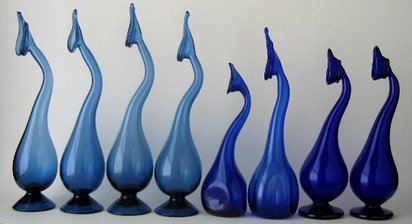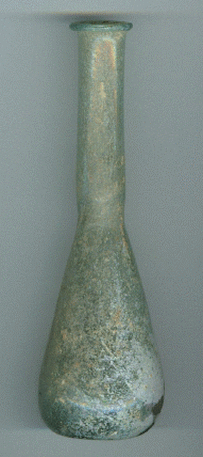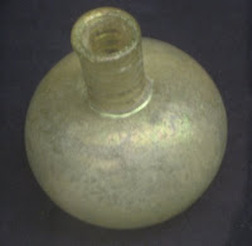
Although not a common item these days, one may still find them at a grave side, used as a vase for a single flower.
Catching the Tears of Mourning
 Various Lacrymatory.
Various Lacrymatory. They are made from terracotta, glass or any other material able to be formed into the required shape. At first, these tear catchers were quite simple, just a small cup or a bottle with a long neck, but later a 'cup' at the top of the stem was formed, to conform to the contours of the eye. Those expressing their sorrow through tears would place the cup over the eye, and any tears brought forth would be caught, falling to the bottom of the vial/bottle.
It is with these implements that one’s sorrow could be measured. In the days of ancient Persia, a sultan would check the contents of his many wives tear catchers, the bottles stoppered between bouts of sadness, in order to tell who missed him the most while he was away.
Through the Ages
 Roman tear catcher.
Roman tear catcher. This brought about an interesting new profession. Women would be paid to cry at funerals, thus filling more tear catchers for the dead, artificially elevating the deceased’s position post mortem. The more tears the paid for mourner shed, the more money they would make.
What was more interesting about these bottles was the fact that the tears were allowed to evaporate. The tear catchers would be placed in the deceased’s tomb, and once the last of the tears had evaporated, the official period of mourning could be ended.
During the time of the Civil War in the US, many women took to capturing their tears over the duration their husbands were away fighting. If the husband returned, the captured tears were a measure of their wives devotion, if the husband died, the tears would be sprinkled over his grave at the first anniversary of his death – the initial period of mourning now over.
Lacrymatoria Today
 Lacrymatory from Portugal.
Lacrymatory from Portugal. Today early tear catchers have become quite collectable, with some fetching high prices on sites like eBay. The art of making the tear catcher is not lost, and some companies still produce them today, however they are largely ornamental. A stroll through a cemetery may see you find a tear catcher adorning someone’s grave, not holding tears, but rather holding a single small flower stem.





 RSS Feed
RSS Feed
